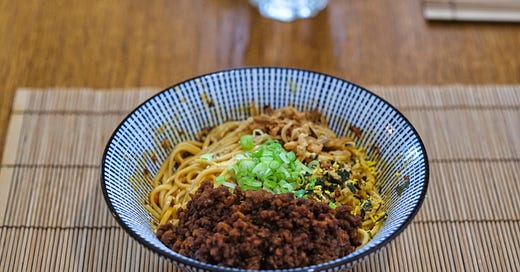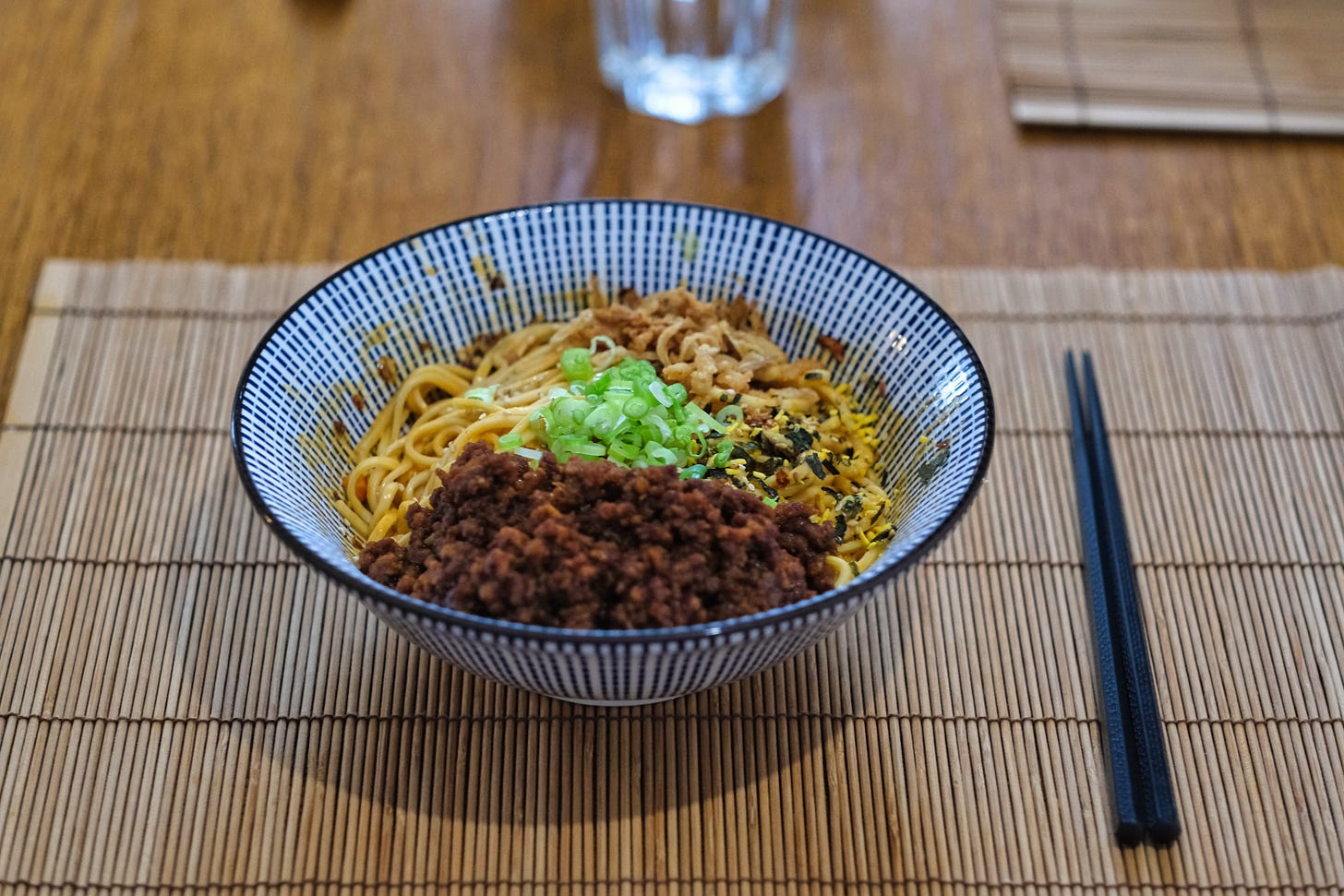Simple, Vegetarian, sesame-based Mazemen
Summer is striking with hot temperatures, but we all love noodles. The solution? A broth-less Ramen!
If you’re not yet a subscriber and like The Ramen Bowl, leave your email to start receiving all the new posts directly in your inbox! 👇
Introduction
Mazemen, also known as Mazesoba or Aburasoba, is a special kind of Ramen… with no soup!
As modern Ramen history is pretty recent, the dish was introduced in the 1950s, but it was popularized only later in 2008 in its “Taiwan mazesoba” version, originally from Nagoya.
Mazesoba is usually served hot, while some just-warm or colder versions do exist. Since summer is approaching, its soup-less nature makes it much more comfortable to eat on hot days without compromising on those flavors that make ramen so tasty.
Today, we aim to deliver a quite simple version that does not require much preparation and scale pretty well with the number of guests to serve. Ideally, the base is vegetarian and does not include animal proteins, but since we all crave that flavor punch, I am dropping some variations at the end of the post for those who want to level up this same recipe. So do not leave until you get there!
This mazesoba recipe comes as inspiration from TanTanMen.
What does it taste like? As you would expect: it tastes just like Ramen, simply without any broth. This specific recipe will have a soy-sesame tare, so the final result will be sort of creamy. Sesame paste (tahini) helps to provide a slightly toasted and nutty flavor, while soy sauce provides saltiness, umami, and a little hint of fresh acidity, also enhanced by the presence of rice vinegar. All the remaining aromatics come in to round up the flavor (and even give some crunchiness).
Recipe
Ingredients
For the sake of control and simplicity, the following are the ingredients for a single bowl of Mazemen. If you are making more than one, simply multiply each ingredient amount!
Noodles (fresh), around 120 grams
Tare
10 mL soy sauce (around 2 tsp), add another teaspoon if feeling extra soy-needing
10 mL tahini (1 full tsp), add a bit more for extra creaminess
2 g rice vinegar (literally, a little tiny splash)
A pinch of grated ginger
A pinch of grated garlic
A splash of Kewpie mayo
30 mL of Aroma Oil (2 tbsp)
Roasted sesame seeds oil, or
Chili crisps oil, or
I use a combination - ◡ -
Toppings
Green onions (a lot of them!)
Sesame seeds
Crispy fried onions
Nori seaweed, cut into little pieces
Shichimi Togarashi
Preparation
Warm up the aroma oil, then set aside.
Cut the green onions and nori, then set aside.
Grate the ginger and the garlic directly into the bowl.
Add all the tare ingredients into a bowl and whisk until smooth.
Add the aroma oil into the bowl and lightly whisk.
Cook the noodles “al dente” then strain and lay them in the bowl.
If you prefer a colder dish, rinse the noodles under cold water.
Optionally, mix the noodles with the sauce.
Place the toppings on the noodles.
Serve it and enjoy!
The Mazemen Framework
When preparing and serving Mazemen/Mazesoba, here is a simple framework that virtually applies to any soup-less ramen dish.
Tare and Aroma Oil go on the bottom of the bowl.
Optionally, some additional oil can be added after the noodles.
Noodles go in.
Optionally give it a little mix with the tare.
Toppings are laid over noodles.
The customer is asked to mix it all together in the bowl.
Again, there is no strict rule, just templates that will help you through a bowl assembly and reasonably work 99% of the time.
Simplifying, you will not have to strictly remember any whole recipe, just keep in mind the framework and adapt it to your recipes.
Wanna level it up?
Eggs
Sous Vide cook eggs at 65° C for 30-45 mins.
Soy-cured egg yolk
Gently add egg yolks in a sealable container with 4 parts soy sauce and 1 part mirin (plus aromatics, optionally). Let marinade between 8 and 24 hours.
Meat
Pork Soboro. This is a must for a “Taiwan mazesoba”.
Suppose you have some leftover Chashu consider chopping it into little cube bites. This Mandarin Chashu recipe might sound interesting!
Substitute the pure nori with some Furikake, a tasty mixture of sesame seeds, chopped seaweed, dried fish, sugar, salt, and monosodium glutamate (it’s not purely “meat”, but there might be a presence of fish, don’t serve it as vegetarian).
Veggies
Bean sprouts, edamame, bok choi, zucchini, these Soy-glazed grilled Eggplants, you name it!
Look at these Japanese-inspired Pickled Red Onions for a hint of summery, crunchy freshness. You could also use a little pickling juice to substitute rice vinegar in the tare ingredients.
Conclusion
What is it that people love about Ramen?
Is it just the umami? Or maybe, the reason has to be found in the immense amount of toppings possibilities. Some others would probably mention those distinguishable chewy noodles.
Whatever the reason is, you will find that all in Mazesoba without compromising on anything but the soup.
In Europe, where I live, you will see nearly every Ramen restaurant starting to change their menu around June, introducing many forms of Mazemen. But soup-less ramen is not just a summer dish! Embrace it and try to make it at home all around the year!
— The Ramen Bowl - ◡ -
If you’re not yet a subscriber and like The Ramen Bowl, leave your email to start receiving all the new posts directly in your inbox! 👇






Thank you! This sounds delicious.
Interesting - a ramen without broth. Perfect for these summer months.